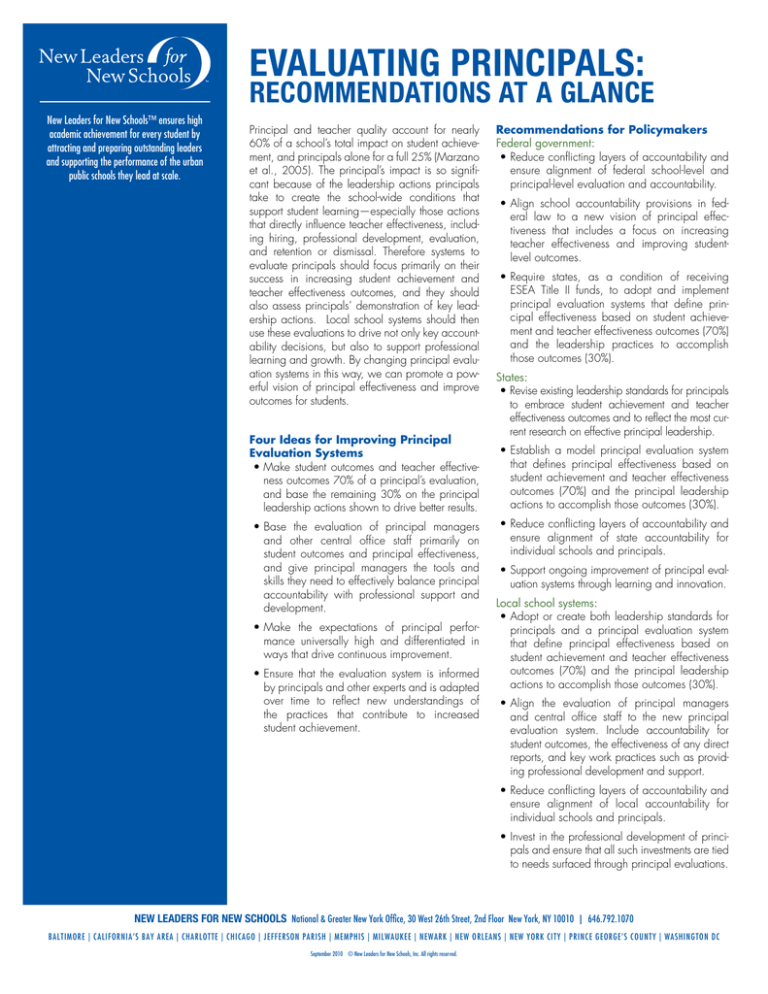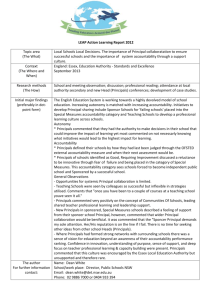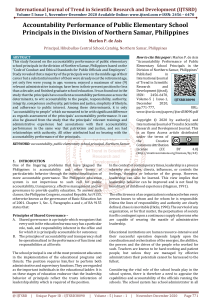
EVALUATING PRINCIPALS:
RECOMMENDATIONS AT A GLANCE
New Leaders for New Schools™ ensures high
academic achievement for every student by
attracting and preparing outstanding leaders
and supporting the performance of the urban
public schools they lead at scale.
Principal and teacher quality account for nearly
60% of a school’s total impact on student achievement, and principals alone for a full 25% (Marzano
et al., 2005). The principal’s impact is so significant because of the leadership actions principals
take to create the school-wide conditions that
support student learning—especially those actions
that directly influence teacher effectiveness, including hiring, professional development, evaluation,
and retention or dismissal. Therefore systems to
evaluate principals should focus primarily on their
success in increasing student achievement and
teacher effectiveness outcomes, and they should
also assess principals’ demonstration of key leadership actions. Local school systems should then
use these evaluations to drive not only key accountability decisions, but also to support professional
learning and growth. By changing principal evaluation systems in this way, we can promote a powerful vision of principal effectiveness and improve
outcomes for students.
Four Ideas for Improving Principal
Evaluation Systems
• Make student outcomes and teacher effectiveness outcomes 70% of a principal’s evaluation,
and base the remaining 30% on the principal
leadership actions shown to drive better results.
• Base the evaluation of principal managers
and other central office staff primarily on
student outcomes and principal effectiveness,
and give principal managers the tools and
skills they need to effectively balance principal
accountability with professional support and
development.
• Make the expectations of principal performance universally high and differentiated in
ways that drive continuous improvement.
• Ensure that the evaluation system is informed
by principals and other experts and is adapted
over time to reflect new understandings of
the practices that contribute to increased
student achievement.
Recommendations for Policymakers
Federal government:
• Reduce conflicting layers of accountability and
ensure alignment of federal school-level and
principal-level evaluation and accountability.
• Align school accountability provisions in federal law to a new vision of principal effectiveness that includes a focus on increasing
teacher effectiveness and improving studentlevel outcomes.
• Require states, as a condition of receiving
ESEA Title II funds, to adopt and implement
principal evaluation systems that define principal effectiveness based on student achievement and teacher effectiveness outcomes (70%)
and the leadership practices to accomplish
those outcomes (30%).
States:
• Revise existing leadership standards for principals
to embrace student achievement and teacher
effectiveness outcomes and to reflect the most current research on effective principal leadership.
• Establish a model principal evaluation system
that defines principal effectiveness based on
student achievement and teacher effectiveness
outcomes (70%) and the principal leadership
actions to accomplish those outcomes (30%).
• Reduce conflicting layers of accountability and
ensure alignment of state accountability for
individual schools and principals.
• Support ongoing improvement of principal evaluation systems through learning and innovation.
Local school systems:
• Adopt or create both leadership standards for
principals and a principal evaluation system
that define principal effectiveness based on
student achievement and teacher effectiveness
outcomes (70%) and the principal leadership
actions to accomplish those outcomes (30%).
• Align the evaluation of principal managers
and central office staff to the new principal
evaluation system. Include accountability for
student outcomes, the effectiveness of any direct
reports, and key work practices such as providing professional development and support.
• Reduce conflicting layers of accountability and
ensure alignment of local accountability for
individual schools and principals.
• Invest in the professional development of principals and ensure that all such investments are tied
to needs surfaced through principal evaluations.
NEW LEADERS FOR NEW SCHOOLS National & Greater New York Office, 30 West 26th Street, 2nd Floor New York, NY 10010 | 646.792.1070
BALTIMORE | CALIFORNIA’S BAY AREA | CHARLOTTE | CHICAGO | JEFFERSON PARISH | MEMPHIS | MILWAUKEE | NEWARK | NEW ORLEANS | NEW YORK CITY | PRINCE GEORGE’S COUNTY | WASHINGTON DC
September 2010 © New Leaders for New Schools, Inc. All rights reserved.



